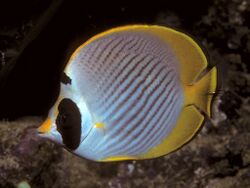Biology:Philippine butterflyfish
| Philippine butterflyfish | |
|---|---|

| |
| Scientific classification | |
| Domain: | Eukaryota |
| Kingdom: | Animalia |
| Phylum: | Chordata |
| Class: | Actinopterygii |
| Order: | Perciformes |
| Family: | Chaetodontidae |
| Genus: | Chaetodon |
| Subgenus: | Chaetodon (Rabdophorus) |
| Species: | C. adiergastos
|
| Binomial name | |
| Chaetodon adiergastos Seale, 1910
| |
The Philippine butterflyfish (Chaetodon adiergastos), the Bantayan butterflyfish or panda butterflyfish,, is a species of marine ray-finned fish, a butterflyfish belonging to the family Chaetodontidae. It is found in the western Pacific, from the Ryukyu Islands and Taiwan to Java and northwestern Australia .[2]
It grows to a maximum length of 20 cm (nearly 8 in).[3] The body is white with diagonal brown stripes on the sides. The dorsal, caudal, anal and pelvic fins are yellow. There are rounded broad black bands on the face, covering the eye, but not continuous from one side of the body to the other but with a separate black spot centered on the forehead.[4]
The Philippine butterflyfish was first formally described in 1910 by the United States ichthyologist Alvin Seale (1871-1958) with the type locality given as Bantayan Island in the Philippines.[5] It belongs to the large subgenus Rabdophorus which might warrant recognition as a distinct genus. In this group, it appears to belong to a loose group including such species as the black butterflyfish (C. flavirostris), diagonal butterflyfish (C. fasciatus), raccoon butterflyfish (C. lunula) and perhaps also the unusual red-tailed butterflyfish (C. collare). Although the coloration of this group varies quite a lot, they are all largish butterflyfishes with an oval outline, and most have a pattern of ascending oblique stripes on the flanks. Except in the red-tailed butterflyfish, there is at least a vestigial form of the "raccoon" mask, with a white space between the dark crown and eye areas.[6][7]
The Philippine butterflyfish is found in coral reefs at depths of 1-30m[3] and occurs in pairs or groups, usually near soft coral. Juveniles are solitary and found on shallow protected reefs or in estuaries.[2]
References
- ↑ Myers, R.F.; Pratchett, M. (2010). "Chaetodon adiergastos". IUCN Red List of Threatened Species 2010: e.T165711A6098073. doi:10.2305/IUCN.UK.2010-4.RLTS.T165711A6098073.en. https://www.iucnredlist.org/species/165711/6098073. Retrieved 20 November 2021.
- ↑ 2.0 2.1 Froese, Rainer and Pauly, Daniel, eds. (2019). "Chaetodon adiergastos" in FishBase. December 2019 version.
- ↑ 3.0 3.1 Dianne J. Bray &. "Chaetodon adiergastos". Fishes of Australia. Museums Victoria. https://fishesofaustralia.net.au/home/species/2372. Retrieved 13 December 2020.
- ↑ "Chaetodon adiergastos". Saltcorner. Bob Goemans. 2012. http://www.saltcorner.com/AquariumLibrary/browsespecies.php?CritterID=465. Retrieved 13 December 2020.
- ↑ Eschmeyer, William N.; Fricke, Ron; van der Laan, Richard, eds. "Species in the genus Chaetodon". California Academy of Sciences. http://researcharchive.calacademy.org/research/ichthyology/catalog/fishcatget.asp?tbl=species&genus=Chaetodon.
- ↑ Fessler, Jennifer L.; Westneat, Mark W (2007). "Molecular phylogenetics of the butterflyfishes (Chaetodontidae): Taxonomy and biogeography of a global coral reef fish family". Molecular Phylogenetics and Evolution 45 (1): 50–68. doi:10.1016/j.ympev.2007.05.018.
- ↑ Hsu, Kui-Ching; Chen, Jeng-Ping; Shao, Kwang-Tsao (2007). "Molecular phylogeny of Chaetodon (Teleostei: Chaetodontidae) in the Indo-West Pacific: evolution in geminate species pairs and species groups". Raffles Bulletin of Zoology Supplement 14: 77–86. http://rmbr.nus.edu.sg/rbz/biblio/s14/s14rbz10_Hsu-pp77-86.pdf.
External links
| Wikimedia Commons has media related to Chaetodon. |
- Photos of Philippine butterflyfish on Sealife Collection
Wikidata ☰ Q2317858 entry
 |


